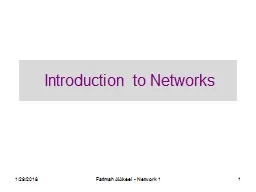

1 Introduction to Networks 1292018 Fatimah AlAkeel Network 1 2 What is a network A number of nodes connected together They share information and resources Examples Roads Telephones Computers ID: 722738
Download Presentation The PPT/PDF document "1/29/2018 Fatimah AlAkeel - Network 1" is the property of its rightful owner. Permission is granted to download and print the materials on this web site for personal, non-commercial use only, and to display it on your personal computer provided you do not modify the materials and that you retain all copyright notices contained in the materials. By downloading content from our website, you accept the terms of this agreement.
Slide1
1/29/2018
Fatimah AlAkeel - Network 1
1
Introduction to NetworksSlide2
1/29/2018
Fatimah AlAkeel - Network 1
2
What is a network ?
A number of nodes connected together.
They share information and resources.
Examples:
Roads, Telephones , ComputersSlide3
1/29/2018
Fatimah AlAkeel - Network 1
3
What is a computer network?
A
computer network
is computers and devices connected together.
The capabilities of a computer are increased when connected with other devices to form a computer network.Slide4
1/29/2018
Fatimah AlAkeel - Network 1
4
Physical NetworkSlide5
1/29/2018
Fatimah AlAkeel - Network 1
5
Computer Network Components
Components of a computer network:
Computer with NIC (PCs, laptops, handhelds)
routers & switches (IP router, Ethernet switch)
Links” Transmission media” (wired, wireless)
protocols (IP,TCP,CSMA/CD,CSMA/CA)
applications (network services)
i.e. Network Operating System (NOS)
humans and service agentsSlide6
1/29/2018
Fatimah AlAkeel - Network 1
6
Purpose of a Computer Network
Summarized in a single word:
sharing
.
Individual computers are isolated.
Networked computers can share resources.
Networks also make computer management easier.
Three types of resources can be shared (Software ,data and hardware)Slide7
1/29/2018
Fatimah AlAkeel - Network 1
7
Share Software and Data
Application and utility software:
can be shared by all users across the network.
This requires only a single software copy to be purchased and maintained.
Data files
:
Can also be shared. This makes data more accessible and maintains integrity.Slide8
1/29/2018
Fatimah AlAkeel - Network 1
8
Share Hardware
Sharing is an essential feature of a computer network.
This reduces costs and the work of support staff.
Printers, fax modems, scanners, hard drives, CD-ROMs, and DVDs can all be shared.Slide9
1/29/2018
Fatimah AlAkeel - Network 1
9
Improve Communications
Communication is essential in today’s businesses.
Computer networks can help in improved communications through groupware.
E-mail, electronic calendars, and video conferencing are available.Slide10
1/29/2018
Fatimah AlAkeel - Network 1
10
Centralize Management
Computer networks allow computers to be managed from one central location.
Software updates can be “pushed” to users’ computers.
Problems can be diagnosed over the network.
Training can be done over the network.Slide11
1/29/2018
Fatimah AlAkeel - Network 1
11
Network Communications
Source
Message
Channel
Receiver
Noise
Feedback
ContextSlide12
1/29/2018
Fatimah AlAkeel - Network 1
12
Network CommunicationsSlide13
1/29/2018
Fatimah AlAkeel - Network 1
13
Types of Networks
Two types of network classifications:
Classified by device
that controls network
Classified by distance
between devicesSlide14
1/29/2018
Fatimah AlAkeel - Network 1
14Slide15
1/29/2018
Fatimah AlAkeel - Network 1
15
I. Peer-to-Peer Network
No single computer controls the network.
Each computer is the same (a peer) to all others.
It is suitable for small offices.
Called “ work group”.
Each user controls the access to his own computer
( read only , hide files).
Its suitable when :
10 or less computers.
All computers in the same place.
Security is not an issue.
No network upgrading plans.Slide16
1/29/2018
Fatimah AlAkeel - Network 1
16
I. Peer-to-Peer Network
Advantages :
Limited cost.
No software needed.
No powerful computers needed.
Easy to install and setup.
Disadvantages:
Not suitable for large networks Slide17
1/29/2018
Fatimah AlAkeel - Network 1
17
I. Peer-to-Peer NetworkSlide18
1/29/2018
Fatimah AlAkeel - Network 1
18
II. Server-Based Network
The network is controlled by a special high-powered server.
The server is dedicated to running the network.
The server never work as a client.
If the number of computers connected together is large , another server is used.
Types:
Print and file servers
Application servers
Communication servers
Directory service serversSlide19
1/29/2018
Fatimah AlAkeel - Network 1
19
II. Server-Based Network
Advantages:
Scheduled Backup
Data is safe
Thousands of users
Any type of computers can be connected.
Easy to access and manage data.
Security ( to have an administrator)Slide20
1/29/2018
Fatimah AlAkeel - Network 1
20
II. Server-Based NetworkSlide21
1/29/2018
Fatimah AlAkeel - Network 1
21Slide22
1/29/2018
Fatimah AlAkeel - Network 1
22
I. Local Area Network
Network computers are located relatively close to each other.
They are generally limited to buildings owned by one organization.
They operate at high speeds
(10-1000 mbps)
They are low-cost networks.Slide23
1/29/2018
Fatimah AlAkeel - Network 1
23
I. Local Area NetworkSlide24
1/29/2018
Fatimah AlAkeel - Network 1
24
II. Metropolitan Area Network
A very fast LAN.
Uses fiber optics as a media.
Covers an area from 20 to 100 meters.Slide25
1/29/2018
Fatimah AlAkeel - Network 1
25
III. Wide Area Network
Network computers are spread out over a larger area.
They are often managed by public carriers.
They operate at lower speeds.
They are a higher-cost network.Slide26
1/29/2018
Fatimah AlAkeel - Network 1
26
III. Wide Area Network